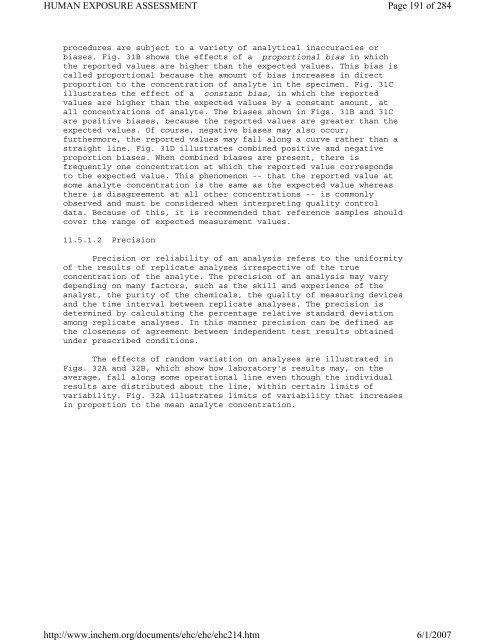Environmental Health Criteria 214
Environmental Health Criteria 214
Environmental Health Criteria 214
Create successful ePaper yourself
Turn your PDF publications into a flip-book with our unique Google optimized e-Paper software.
HUMAN EXPOSURE ASSESSMENT<br />
procedures are subject to a variety of analytical inaccuracies or<br />
biases. Fig. 31B shows the effects of a proportional bias in which<br />
the reported values are higher than the expected values. This bias is<br />
called proportional because the amount of bias increases in direct<br />
proportion to the concentration of analyte in the specimen. Fig. 31C<br />
illustrates the effect of a constant bias, in which the reported<br />
values are higher than the expected values by a constant amount, at<br />
all concentrations of analyte. The biases shown in Figs. 31B and 31C<br />
are positive biases, because the reported values are greater than the<br />
expected values. Of course, negative biases may also occur;<br />
furthermore, the reported values may fall along a curve rather than a<br />
straight line. Fig. 31D illustrates combined positive and negative<br />
proportion biases. When combined biases are present, there is<br />
frequently one concentration at which the reported value corresponds<br />
to the expected value. This phenomenon -- that the reported value at<br />
some analyte concentration is the same as the expected value whereas<br />
there is disagreement at all other concentrations -- is commonly<br />
observed and must be considered when interpreting quality control<br />
data. Because of this, it is recommended that reference samples should<br />
cover the range of expected measurement values.<br />
11.5.1.2 Precision<br />
Precision or reliability of an analysis refers to the uniformity<br />
of the results of replicate analyses irrespective of the true<br />
concentration of the analyte. The precision of an analysis may vary<br />
depending on many factors, such as the skill and experience of the<br />
analyst, the purity of the chemicals, the quality of measuring devices<br />
and the time interval between replicate analyses. The precision is<br />
determined by calculating the percentage relative standard deviation<br />
among replicate analyses. In this manner precision can be defined as<br />
the closeness of agreement between independent test results obtained<br />
under prescribed conditions.<br />
The effects of random variation on analyses are illustrated in<br />
Figs. 32A and 32B, which show how laboratory's results may, on the<br />
average, fall along some operational line even though the individual<br />
results are distributed about the line, within certain limits of<br />
variability. Fig. 32A illustrates limits of variability that increases<br />
in proportion to the mean analyte concentration.<br />
http://www.inchem.org/documents/ehc/ehc/ehc<strong>214</strong>.htm<br />
Page 191 of 284<br />
6/1/2007

















